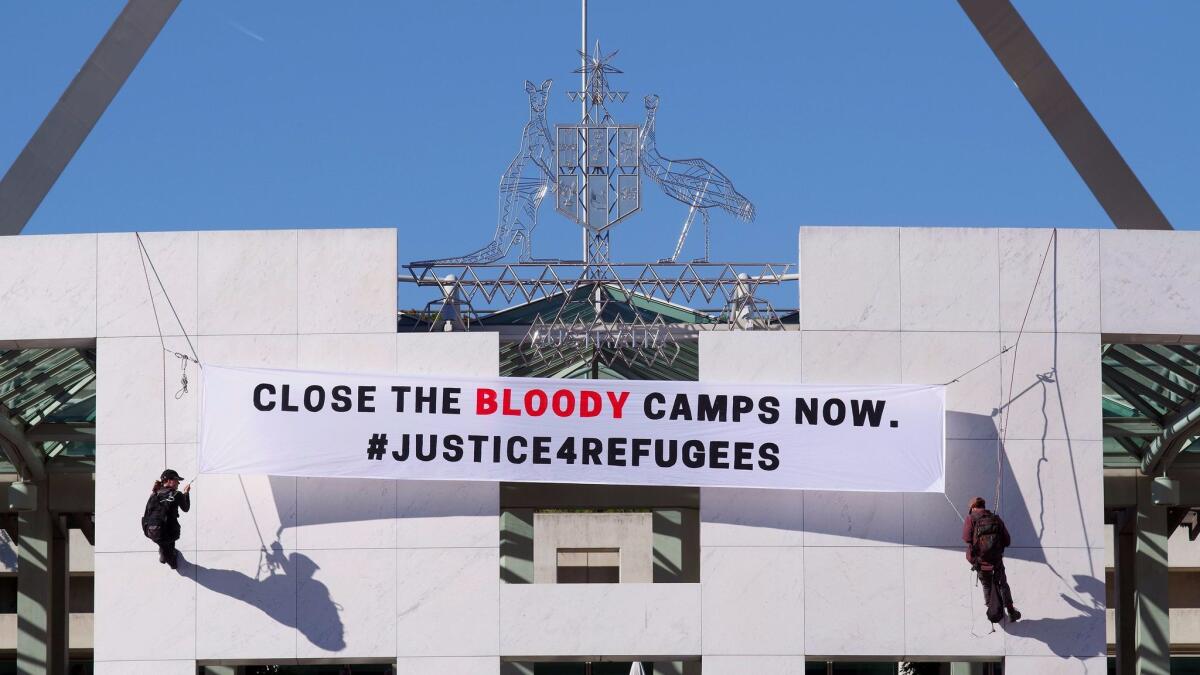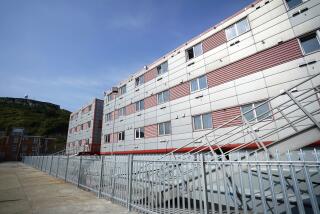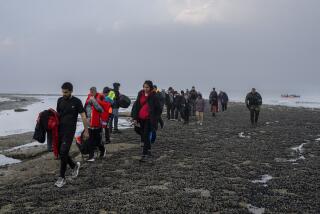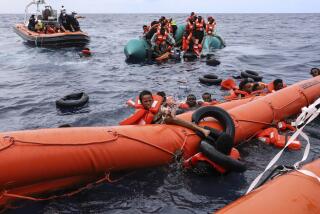Australia closes the door on migrant boats. Will it be a model for Europe?

- Share via
When activists rappelled down the front of Australia’s parliament last week to protest the country’s rigid refugee policy, then stood ankle-deep in a moat they had dyed blood-red, Sen. James McGrath from Queensland, one of the top ministers in the government, called them a selfish “bunch of grubs.”
The protesters unfurled a banner with the message, “Close the bloody camps now. #Justice4Refugees,” a reference to the outsourced camps set up in nearby nations for those seeking asylum and resettlement in Australia.
The demonstration, the second such protest at Australia’s parliament in two days, drew attention to the country’s controversial “Stop the Boats” policy, which officials say is intended to save lives by discouraging risky refugee voyages on the high seas.
Under the policy, any smugglers’ vessels nearing Australian shores are sent away with tough warnings that no asylum seeker who tries to reach Australia by boat will ever call the country home.
Instead, Australia sends would-be immigrants to offshore camps on Papua New Guinea’s Manus Island and in the tiny Pacific island nation of Nauru, much as the U.S. used its military prison at Guantanamo Bay, Cuba, in the 1990s to detain asylum seekers from Haiti.
The policy, supported by both major political parties, has succeeded in stopping the influx of boats and drownings at sea near Australian shores.
It also has drawn intense criticism from human rights organizations around the world, which have documented cases of abuse, inhumane treatment and neglect among migrants trapped in substandard offshore detention centers under Australia’s take-no-boaters policy.
“Australia’s policy of exiling asylum seekers who arrive by boat is cruel in the extreme,” Anna Neistat, senior director for research at Amnesty International, said in the group’s report on migrants who’d been held at Australia’s behest on Nauru — most for at least three years. “Few other countries go to such lengths to deliberately inflict suffering on people seeking safety and freedom.”
Few other countries go to such lengths to deliberately inflict suffering on people seeking safety and freedom.
— Anna Neistat, senior director for research at Amnesty International
Now, amid rising anti-immigrant sentiment in Europe — seen in Britain’s vote to leave the European Union and strong recent showings at the polls in various countries by parties of the far right — some European politicians are expressing interest in the Australian immigration model.
The German Interior Ministry last month floated the idea of a program to intercept asylum seekers by boat and take them to other countries to be processed.
“The elimination of the prospect of reaching the European coast could convince migrants to avoid embarking on the life-threatening and costly journey in the first place. The goal must be to remove the basis for people-smuggling organizations and to save migrants from the life-threatening journey,” a ministry spokeswoman told the Welt am Sonntag newspaper.
In Denmark, Kenneth Kristensen Berth, spokesman on Europe for the right-wing Danish People’s Party, part of the governing coalition, recently came out in support of considering processing camps for migrants outside Denmark’s borders.
Nigel Farage, who helped lead the “Brexit” campaign to leave the EU as leader of the U.K. Independence Party, praised Australia’s policy, and in September, British Foreign Secretary Boris Johnson called on Europe to turn back asylum seekers’ boats close to where they shove off from Libya to prevent them from reaching Italy. Johnson and other Brexit leaders called for an Australian-style immigration policy that opens the door to would-be migrants on a points system based on what they can contribute to the country.
Analysts say it would be difficult for Europe to try to refuse boats loaded with migrants attempting to land on European shores or try to have them shipped elsewhere.
For one thing, turning back people smugglers’ vessels would be illegal in the Mediterranean, after a 2012 ruling in the European Court of Human Rights that found that Italy violated migrants’ rights by returning a vessel with asylum seekers to Libya.
Then there’s the prohibitive cost to run the offshore detention centers. Australia paid private contractors more than $320,000 per person per year in 2013-14 to run its facilities for refugees and asylum seekers.
Last year, the EU considered processing asylum seekers offshore in Egypt or Tunisia, but instead reached a deal with Turkey in March that contained the flow of asylum seekers from Turkey to Europe in return for humanitarian aid to support them.
That deal, however, looks on the brink of collapse, with Turkey threatening to reopen the floodgates, angered over a temporary halt to talks on its bid for EU membership. Europe has begun negotiating with Tunisia in a bid to get a similar agreement to slow the flow of asylum seekers from North Africa, many of whom are not fleeing war and thus are likely to be rejected as refugees.
Europe saw an influx of at least 1.25 million asylum seekers in 2015, according to an EU briefing paper in April. The International Organization for Migration said 159,496 migrants had reached Europe by sea this year, and 4,220 had drowned.
The Australian government last month doubled down on its controversial migrant boats policy, introducing legislation for a lifetime visa ban on asylum seekers being detained on Manus Island or Nauru, regardless of where they eventually settle.
The bill is unlikely to pass, after the opposition announced it would not support it.
It also appears to not have much public support. A poll by the Australia Institute in June found that 63% of respondents oppose the government’s policy of turning away those who have a legitimate case for asylum merely because they arrived by boat.
Australian officials say the policy is an attempt not to block migration but to avoid rewarding those who “jump the queue” ahead of other needy refugees who follow legal procedures and apply for asylum through the United Nations.
Australia ranks third behind the U.S. and Canada in admissions of refugees through the U.N. High Commissioner for Refugees process.
Twitter: @RobynDixon_LAT
ALSO
Deaths on the Mediterranean Sea don’t keep migrants from trying to reach Europe
A journey through ‘hell’: First wave of migrant children from Calais arrives in Britain
More to Read
Sign up for Essential California
The most important California stories and recommendations in your inbox every morning.
You may occasionally receive promotional content from the Los Angeles Times.










